A rainbow is an optical and meteorological phenomenon that causes a nearly continuous spectrum of light to appear in the sky when the Sun shines onto droplets of moisture in the Earth's atmosphere. It takes the form of a multicolored arc, with red on the outside and violet on the inside. Even though a rainbow spans a continuous spectrum of colors, traditionally the full sequence of colors is most commonly cited as red, orange, yellow, green, blue, and violet. It is commonly thought that indigo was included due to the different religious connotations of the numbers six and seven at the time of Isaac Newton's work on light, despite its lack of scientific significance and the poor ability of humans to distinguish colors in the blue portion of the visual spectrum.
The rainbow effect can be observed whenever there are water drops in the air and sunlight shining from behind the observer at a low altitude or angle. The most spectacular rainbow displays when half of the sky is still dark with draining clouds and the observer is at a spot with clear sky overhead. The rainbow effect is also commonly seen near waterfalls or fountains.
Rainbow fringes can sometimes be seen at the edges of backlit clouds and as vertical bands in distant rain or virga. The effect can also be artificially created by dispersing water droplets into the air during a sunny day.In a very few cases, a moonbow, or night-time rainbow, can be seen on strongly moonlit nights. As human visual perception for colour in low light is poor, moonbows are most often perceived to be white.
The rainbow's appearance is caused by dispersion of sunlight as it is refracted by (approximately spherical) raindrops. The light is first refracted as it enters the surface of the raindrop, reflected off the back of the drop, and again refracted as it leaves the drop. The overall effect is that the incoming light is reflected back over a wide range of angles, with the most intense light at an angle of about 40 degrees - 42 degrees. This angle is independent of the size of the drop, but does depend a lot on its shape and refractive index. Due to the surface tension waterdrops are always round and the refractive index of pure water is always 1.33. Seawater, on the other hand has a higher refractive index, which results in a smaller angle. This is easily measurable when a 'rain'bow is created from splashing up seawaves.
Since the water is dispersive, the amount that the sunlight is bent depends upon the wavelength, and hence colour, of the light's constituent parts. Blue light is refracted at a greater angle than red light, but because the area of the back of the droplet has a focal point inside the droplet, the spectrum crosses itself, and therefore the red light appears higher in the sky, and forms the outer color of the rainbow.
Contrary to popular belief, the light at the back of the raindrop does not undergo total internal reflection; however, light that emerges from the back of the raindrop does not create a rainbow between the observer and the Sun. The spectra emitted from the back of the raindrop do not have a maximum of intensity, as the other visible rainbows do, and thus the colors blend together and do not form a rainbow.
A rainbow does not actually exist at a location in the sky, but rather is an optical phenomenon whose apparent position depends on the observer's location. All raindrops refract and reflect the sunlight in the same way, but only the light from some raindrops reaches the observer's eye.
These raindrops are perceived to constitute the rainbow by that observer. The position of a rainbow in the sky is always in the opposite direction of the Sun with respect to the observer, and the interior is always slightly brighter than the exterior.
The bow is centered on the shadow of the observer's head, or more exactly at the antisolar point (which is below the horizon during the daytime), appearing at an angle of approximately 40 degrees - 42 degrees to the line between the observer's head and its shadow. As a result, if the Sun is higher than 42 degrees, then the rainbow is below the horizon and cannot be seen as there are usually not enough raindrops between the horizon (that is: eye height) and the ground, to contribute.
One exception is when the observer is at the top of a mountain or a similar vantage point, for example an aeroplane (see below). Another exception occurs when the rainbow is produced by a garden sprinkler. Although in this case to get sufficient drops they must be very small, resulting in a quite colorless bow. It is difficult to photograph the complete arc of a rainbow, which would require an angle of view of 84 degrees.
For a 35 mm camera, a lens with a focal length of 19 mm or less would be required, whilst most photographers are only likely to have a 28 mm wide-angle lens.
From an airplane, one has the opportunity to see the whole circle of the rainbow, with the plane's shadow in the center. This phenomenon can be confused with the glory, but a glory is usually much smaller, covering only 5 degrees - 20 degrees, as opposed to over 80 degrees for a full circle rainbow. Speed and direction of light in materials?
- In a vacuum all frequencies of light travel at the same speed but in a material, the speed is reduced.
- The ratio of the speed of light in a vacuum, c, to the speed of light in a material, v, is the index of refraction,
- n = c / v.n equals about 1.333 in water
The change in speed causes the direction of a light beam to change. There is a relationship between the angles at which light enters and leaves a boundary between materials with different indices of refraction called Snell's law. It is: n1 * sin (theta1) = n2 * sin (theta2)
Variations
Occasionally, a second, dimmer secondary rainbow is seen outside the primary bow. Secondary rainbows are caused by a double reflection of sunlight inside the raindrops, and appear at an angle of 50 degrees - 53 degrees. As a result of the second reflection, the colours of a secondary rainbow are inverted compared to the primary bow, with blue on the outside and red on the inside. The dark area of unlit sky lying between the primary and secondary bows is called Alexander's band, after Alexander of Aphrodisias who first described it.
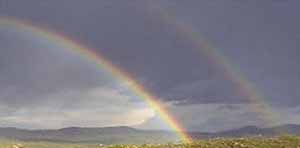
Double Rainbow Photo
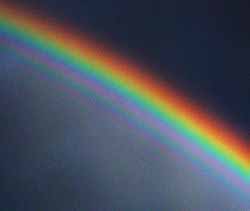
Contrast-enhanced photograph of a supernumerary rainbow,
with additional green and purple arcs inside the primary bow.
Occasionally, another beautiful and striking rainbow phenomenon can be observed, consisting of several faint rainbows on the inner side of the primary rainbow, and very rarely also outside the secondary rainbow. They are slightly detached and have pastel colour bands that do not fit the usual pattern. They are known as supernumerary rainbows, and it is not possible to explain their existence using classical geometric optics.
The alternating faint rainbows are caused by interference between rays of light following slightly different paths with slightly varying lengths within the raindrops. Some rays are in phase, reinforcing each other through constructive interference, creating a bright band; others are out of phase by up to half a wavelength, cancelling each other out through destructive interference, and creating a gap. Given the different angles of refraction for rays of different colours, the patterns of interference are slightly different for rays of different colours, so each bright band is differentiated in colour, creating a miniature rainbow. Supernumary rainbows are clearest when raindrops are small and of similar size. The very existence of supernumary rainbows was historically a first indication of the wave nature of light, and the first explanation was provided by Thomas Young in 1804.
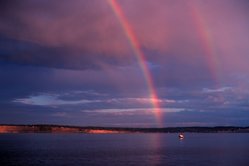
Primary and secondary rainbows are visible, as well as a
reflected primary and a faintly visible reflection primary.
A reflected rainbow, by contrast, is produced when light that has first been reflected inside raindrops then reflects off a body of water before reaching the observer. A reflected rainbow is not a mirror image of the primary bow, but is displaced from it to a degree dependent on the Sun's altitude. Both types can be seen in the image to the right.
The work of Robert Grosseteste on light was continued by Roger Bacon, who wrote in his Opus Majus of 1268 about experiments with light shining through crystals and water droplets showing the colors of the rainbow.
Theodoric of Freiberg is also known to have given an accurate theoretical explanation of both the primary and secondary rainbows in 1307. He explained the primary rainbow, noting that "when sunlight falls on individual drops of moisture, the rays undergo two refractions (upon ingress and egress) and one reflection (at the back of the drop) before transmission into the eye of the observer" (quoted from David C, Lindberg, Roger Bacon'sTheory of the Rainbow: Progress or Regress?, Isis, Vol. 57, no. 2, p. 235). He explained the secondary rainbow through a similar analysis involving two refractions and two reflections.
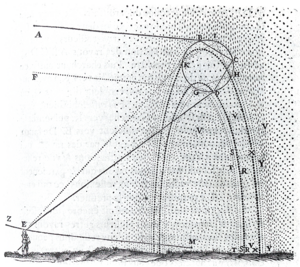
RenŽ Descartes' sketch of how primary and secondary rainbows are formed
Descartes, in 1637, further advanced this explanation. Knowing that the size of raindrops didn't appear to affect the observed rainbow, he experimented with passing rays of light through a large glass sphere filled with water. By measuring the angles that the rays emerged, he concluded that the primary bow was caused by a single internal reflection inside the raindrop and that a secondary bow could be caused by two internal reflections. He was able to back this up with a derivation of the law of refraction (subsequently, but independently of, Snell) and correctly calculated the angles for both bows. His explanation of the colors, however, was based on a mechanical version of the traditional theory that colors were produced by a modification of white light.
Isaac Newton was the first to demonstrate that white light was composed of the light of all the colors of the rainbow, which a glass prism could separate into the full spectrum of colours, rejecting the theory that the colors were produced by a modification of white light. He also showed that red light gets refracted less than blue light, which led to the first scientific explanation of the major features of the rainbow. Newton's corpuscular theory of light was unable to explain supernumary rainbows, and a satisfactory explanation was not found until Thomas Young realised that light behaves as a wave under certain conditions, and can interfere with itself.
Young's work was refined in the 1820s by George Biddell Airy, who explained the dependence of the strength of the colours of the rainbow on the size of the water droplets. Modern physical descriptions of the rainbow are based on Mie scattering, work published by Gustav Mie in 1908. Advances in computational methods and optical theory continue to lead to a fuller understanding of rainbows. For example, Nussenzveig provides a modern overview.
Circumhorizon Arcs
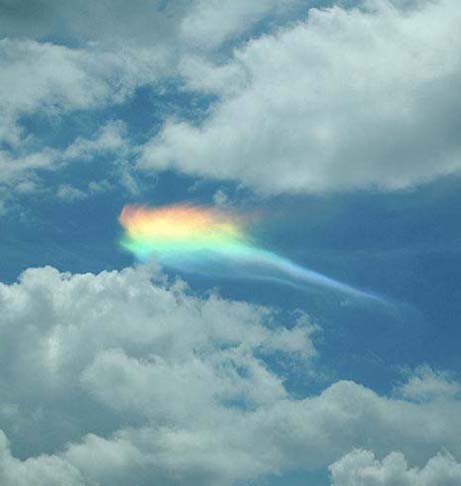
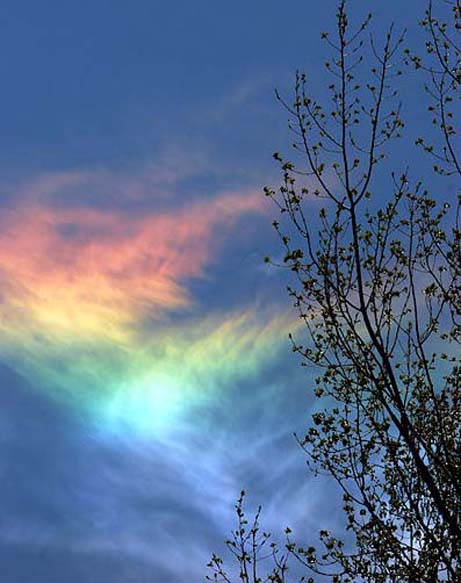
Circumhorizon Arc Wikipedia
A circumhorizonal arc or circumhorizon arc (CHA), also known as a "fire rainbow", is a halo or an optical phenomenon similar in appearance to a horizontal rainbow, but in contrast caused by the refraction of light through the ice crystals in cirrus clouds.
It occurs only when the sun is high in the sky, at least 58 degrees above the horizon, and can only occur in the presences of cirrus clouds. It can thus not be observed at locations north of 55 degrees N or south of 55 degrees S, except occasionally at higher latitudes from mountains. To be visible the sun must be at an elevation of 57.8 degrees (90 -32.2 degrees) or more and if cloud conditions are right it is seen along the horizon on the same side of the sky as the sun. It reaches its maximum intensity at a sun elevation of 67.9 degrees.
The phenomenon is quite rare because the ice crystals must be aligned horizontally to refract the high sun. The arc is formed as light rays enter the horizontally-oriented flat hexagonal crystals through a vertical side face and exit through the horizontal bottom face. It is the 90 degrees inclination that produces the well-separated rainbow-like colours and, if the crystal alignment is just right, makes the entire cirrus cloud shine like a flaming rainbow.
A circumhorizontal arc can be confused with an infralateral arc when the sun is high in the sky; the former is however always oriented horizontally where the latter is oriented as a section of a rainbow, e.g. as an arc stretching upwards from the horizon.
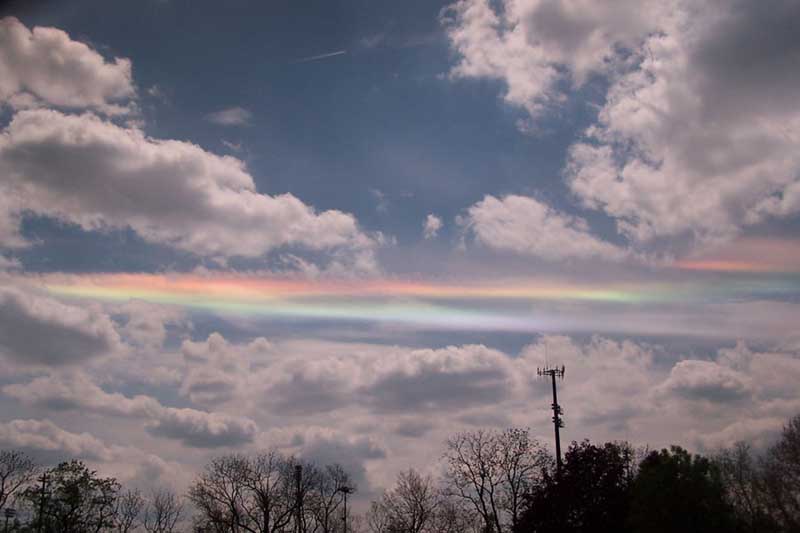
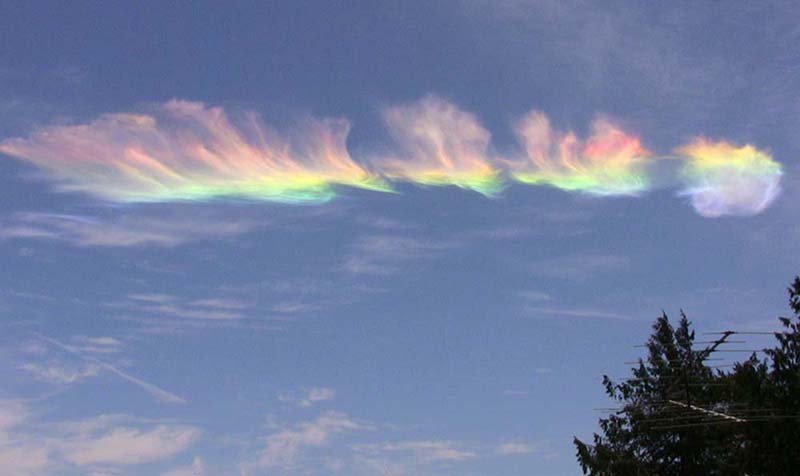
Circumhorizon Arc - Summer Halo Atmospheric Optics
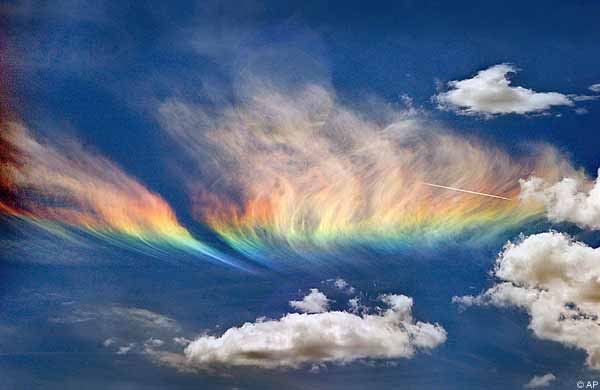
Rare Rainbow Over Idaho - "Rainbow Fire" - Circumhorizon Arc
National Geographic June 19, 2006
Rainbows in the News ...
Secret of 'twinned rainbows' simulated on a computer MSNBC - December 11, 2011
Researchers in San Diego say they've discovered how a rare "twinned rainbow" works and can now simulate one on a computer. By studying virtual rainbows, they figured out that the twinned rainbow needs sunlight to reflect off both small and large size water droplets at just the right angle. "A double rainbow everyone has seen," said Iman Sadeghi, a Google software engineer and former doctoral student at the University of California San Diego's Jacobs School of Engineering. Sadeghi says the image of any rainbow is dependent on the shape of the water droplets in the air, as well as the angle between the observer, the water droplets and the sun behind the observer.
Quadruple rainbow' caught on film for the first time BBC - October 6, 2011
Scientists have captured the first image of a "quaternary" rainbow - the fourth rainbow caused by the bending of light through water in the air. This refraction frequently creates a visible second rainbow, but until now, no one had caught sight of the fainter third and fourth arcs that the process creates in a different part of the sky. The first tertiary, or third, rainbow has only just been caught on film. Digitally enhanced pictures of the two effects appear in Applied Optics.
Scientists Stop Light in 'Trapped Rainbow' Live Science - November 15, 2007

Scientists have worked out how to bring beams of light to a screeching halt inside a material that would separate the light into its constituent colors, creating a rainbow - a trapped rainbow. To bring light to a stop from its usual approximately 670 million mph (1.08 billion km/h) pace is no easy feat, and scientists have been working on the problem for years in hopes of revolutionizing how information is stored and sent.
Double Rainbows

A double rainbow features reversed colors in the outer (secondary) bow, with the dark Alexander's band between the bows. Although most people will not notice it because they are not actively looking for it, a dim secondary rainbow is often present outside the primary bow. Secondary rainbows are caused by a double reflection of sunlight inside the raindrops, and appear at an angle of 50-53 degrees. As a result of the second reflection, the colours of a secondary rainbow are inverted compared to the primary bow, with blue on the outside and red on the inside. The secondary rainbow is fainter than the primary because more light escapes from two reflections compared to one and because the rainbow itself is spread over a greater area of the sky. The dark area of unlit sky lying between the primary and secondary bows is called Alexander's band, after Alexander of Aphrodisias who first described it.
Very dim tertiary (triple) and even quaternary (quadruple) rainbows have been photographed. These are caused by triple or quadruple reflections of sunlight inside the raindrops. Such rainbows appear on the same side of the sky as the sun, at about 40¡ from the sun for tertiary and 45¡ from the sun for quaternary rainbows. It is difficult to see these types of rainbows with the naked eye because of the sun's glare.
Higher-order rainbows were described by Felix Billet (1808-1882) who depicted angular positions up to the 19th-order rainbow, a pattern he called a "rose of rainbows". In the laboratory, it is possible to observe higher-order rainbows by using extremely bright and well collimated light produced by lasers. Up to the 200th-order rainbow was reported by Ng et al. in 1998 using a similar method but an argon ion laser beam
Secret of 'twinned rainbows' simulated on a computer MSNBC - December 11, 2011
Researchers in San Diego say they've discovered how a rare "twinned rainbow" works and can now simulate one on a computer. By studying virtual rainbows, they figured out that the twinned rainbow needs sunlight to reflect off both small and large size water droplets at just the right angle. "A double rainbow everyone has seen," said Iman Sadeghi, a Google software engineer and former doctoral student at the University of California San Diego's Jacobs School of Engineering. Sadeghi says the image of any rainbow is dependent on the shape of the water droplets in the air, as well as the angle between the observer, the water droplets and the sun behind the observer.
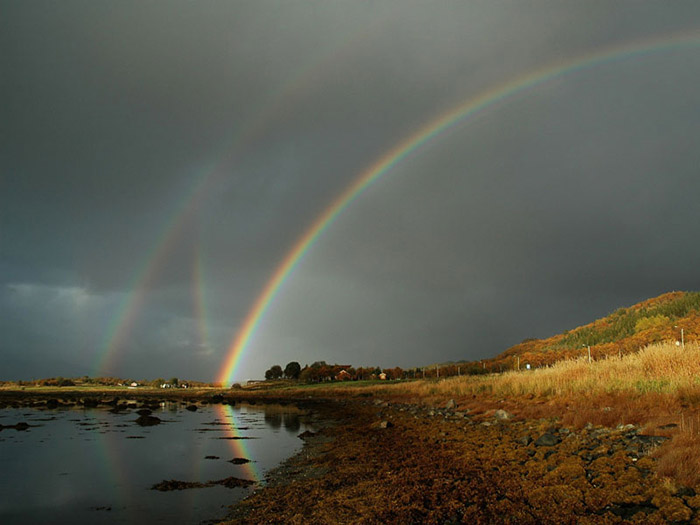
NASA - September 11, 2007
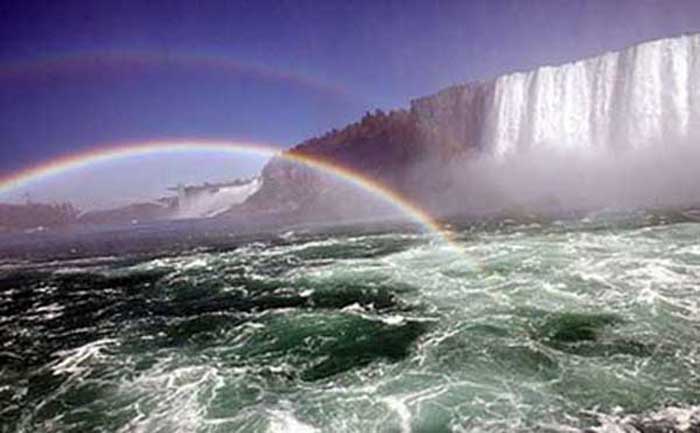
AP - October 9, 2006
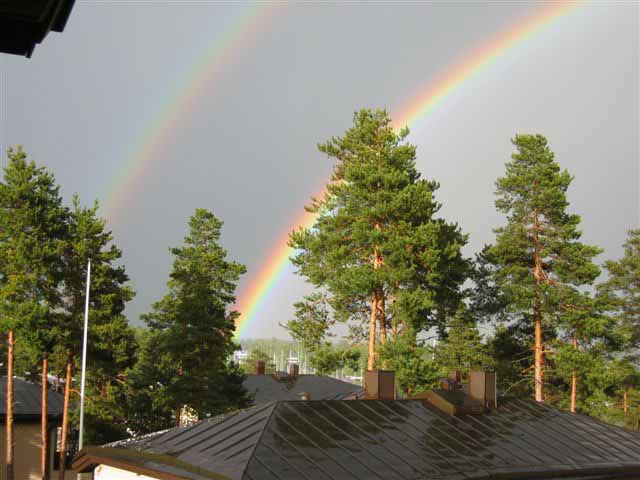
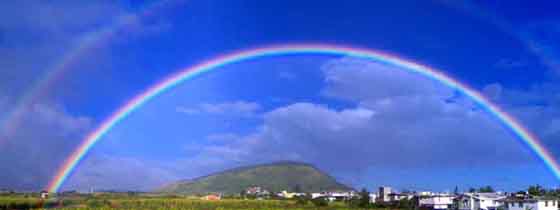 Double Rainbows Google Images
Double Rainbows Google ImagesLightning and Rainbows
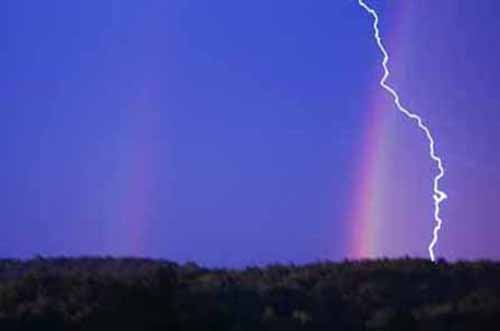
From Spaceweather.com
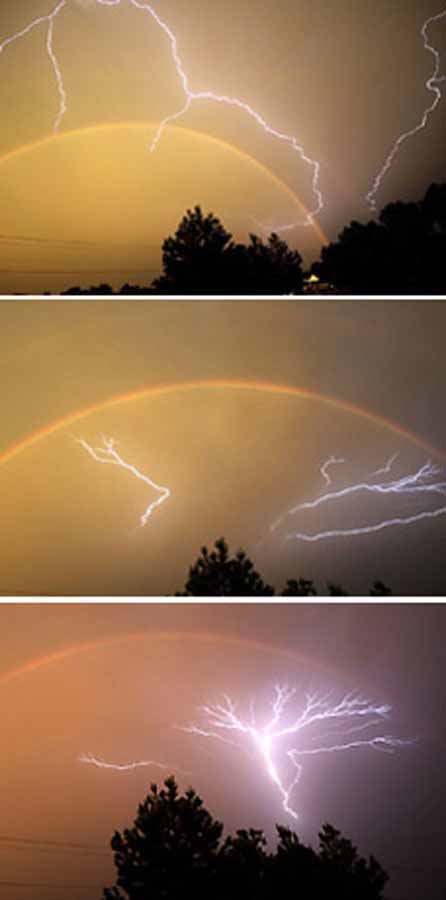
Lightning sharing the sky with a rainbow
Arkansas - Daily Mail - July 13, 2006
Lightning often occurs during heavy storms while rainbows are generally formed after the rain has stopped, making an appearance of both simultaneously relatively rare. The actual electric charge in a flash of lightning comes from particles from the sun sent out in the solar wind which gather in the outer atmospheric layers before creating a strike. Scientists are still divided by what actually causes lightning, with one theory suggesting falling droplets of ice and rain become electrically polarised as they fall through the natural electric field in the Earth's atmosphere. This would explain why lightning often accompanies storms and heavy rain. The same droplets also cause the rainbow, when light from the sun is refracted by the water to cause a spectrum.
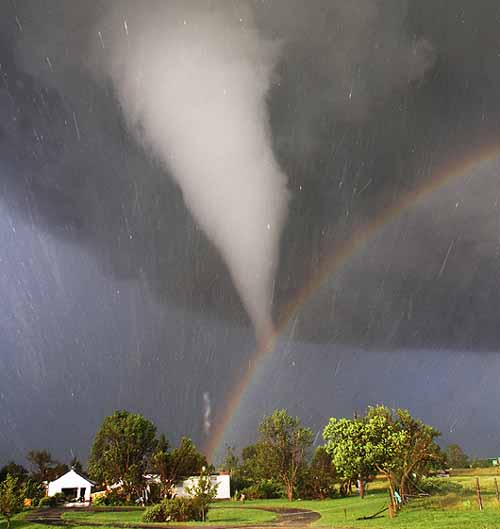
Tornado and Rainbow Over Kansas
NASA - July 2, 2006
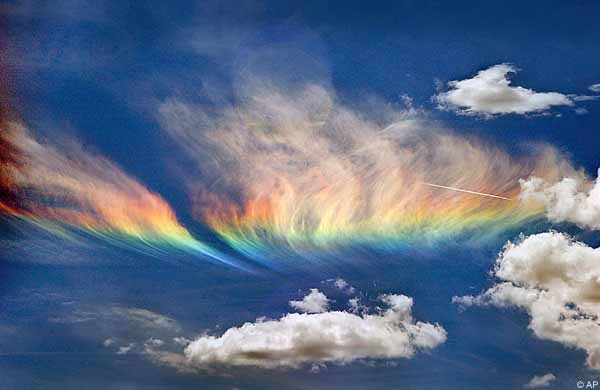
Rare "Rainbow" Spotted Over Idaho
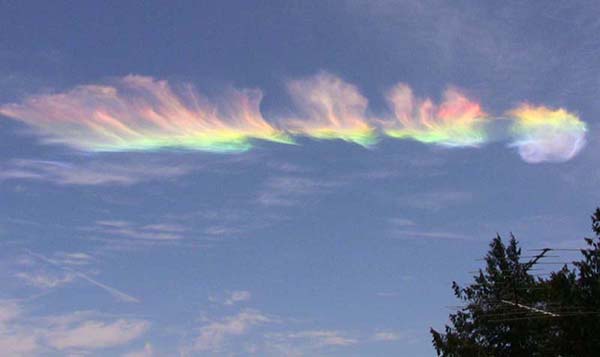
Rainbows - Circumhorizonal Arcs, Fire Rainbows
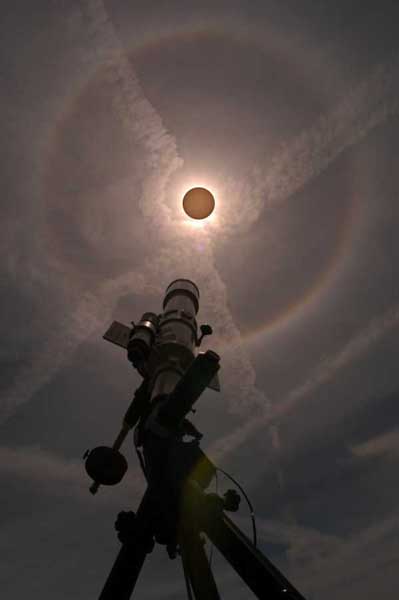
Solar Halo, Sun Dog, Sun SpokesSolar Halos Google Images
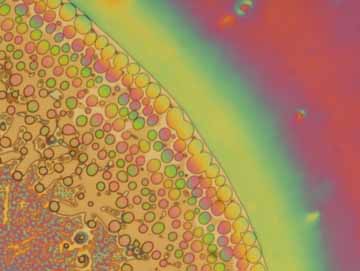
RAINBOWS - SCIENCE
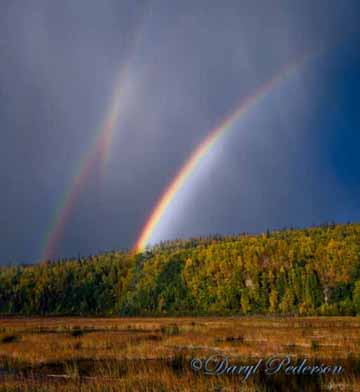
TRIPE RAINBOWS
NOTE : All Picture is from Google Image
